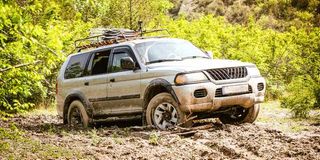Premium
Here’s how to iron out corrugations

The popular maxim is to drive fast enough to “iron out” the ripples, or go dead slowly. Never some half-hearted speed in between, because that could break a fragile vehicle and inflict maximum wear-and-tear on a robust one.
Hi there, could you talk to us a bit about driving on corrugations? What options are there besides the 'kanyanga mafuta' 80kph in an overloaded cruiser approach one seems to see everywhere and many times with disastrous results? Also, what tips do you have for towing people out of the mud? Teddy
The popular maxim is to drive fast enough to “iron out” the ripples, or go dead slowly. Never some half-hearted speed in between, because that could break a fragile vehicle and inflict maximum wear-and-tear on a robust one.
Corrugations are essentially a sequence of little hills and valleys. The height of the peaks and troughs, and the distance between them, will vary according to the road materials and the type of vehicles that mostly use the road (their wheel size and ambient speed).
If you choose “dead slow”, your own tyres will go all the way up and down each mini hill and valley one at a time. That will test your over-shoulder-boulder-holders and wobble your whatsits, but probably avoid damage to anything except your timetable.
For a relatively smooth ride, you will need to go a lot faster. Exactly how fast will depend on your car, its suspension ratings, and the size and spacing of the ripples? Looked at in slow motion, at speed, the wheel will not have time to go all the way down the valleys and will essentially be skipping across the tops of the peaks.
At the right speed, there should be little or no discomfort and minimal up-and-down for either the suspension or the vehicle’s occupants – just a thrum.
Commonly, on moderate ripples that speed will be about 60 kph, and upwards from there if the bumps are wider apart (and usually also bigger). Speeds higher than 80 will seldom be necessary but sometimes they will. You will have to discover the optimum pace by trial and error and feel on each occasion.
This is definitely the most comfortable option for a strong car and an experienced driver, but if you are not familiar with off-tarmac driving or your car is in fragile condition, it is not recommended on severe ripples or over long distances. And all drivers, in any car, should be aware of three downsides to the kanyanga mafuta remedy:
First, as you build up to the necessary/ideal speed, or slow down for a hazard or a stop, you will go through the “half-hearted” phases which might deliver a severe shuddering and severely test the suspension. Worn bushes will bang and soft shock absorbers will allow the wheels to bounce. In short, the bumping will get worse and control will be compromised until the right speed irons things out.
Second, during the build-up or slow-down, vehicles with poor suspensions might skitter and tramp. And even when the right speed is reached and everything smooths out the car will have less traction and might feel as if it is floating slightly from side to side. Sensing that and dealing with it is second nature to experienced drivers, but it might be unsettling to those who have not driven much off the tarmac. You must use your own self-judgment on whether to press on and learn, or obey your sphincter and revert to the dead slow option.
Third, by using speed to reduce the distance the suspension moves up and down, the slighter but much more rapid flexions at speed will act on a very small part of the shock-absorber shaft where it passes through the oil seal. That both generates more heat and concentrates it. In most conditions over a period of several minutes, the temperature at the seal will probably remain below the threshold (of about 500 degrees) and no major or lasting harm will be done. In extreme conditions over a longer period, it is possible that the threshold will be passed and the seal will distort, allowing hydraulic oil to leak out. From there on the weakening of hydraulic pressure will progressively damage the shock to a point of total failure.
Quite frequent cool-down periods can ameliorate this effect, and if severe corrugations are a major part of your everyday motoring environment there is a technical modification that could help: fit a can of water under the passenger seat and arm it with a windscreen washer pump with piping to well-aimed nozzles in all four wheel arches, so if the shocks are showing signs of getting too hot you can squirt water on the dampers to cool them down before they fail.
Peugeot developed that system in the Kerio Valley for their 205 T16 in the Safari Rally. It works. At that level, there was of course also telemetry which displayed the temperature of the oil seals on a dial on the dashboard! My job was to press the squirt button when necessary, which was quite often in a car “ironing out” the ripples at up to 200 kph.
The reason cars get stuck in mud and how to unplug them
There are many factors that can cause a vehicle to get stuck and a whole menu of optional measures to remedy the problems. But all of those boil down to a very simple principle: Cars get stuck when the resistance of deep mud or sand against the wheels and possibly the undercarriage and bodywork is greater than the momentum of the vehicle and the traction its tyres can deliver to keep propelling it forwards.

There are many factors that can cause a vehicle to get stuck and a whole menu of optional measures to remedy the problems.
So, getting them unstuck is always a question of reducing the resistance and/or increasing the traction.
Reducing resistance means digging away the mud or sand that is dragging against the car (wheels and undercarriage) and/or jacking up the bodywork until it is in fresh air (and putting things under the tyres to keep it up). Improving traction means putting rocks, logs, mats or ladders under the drive tyres, or fitting chains, or towing with either a winch or another vehicle.
Towing can be the simplest solution if there is another vehicle and a stout towing cord or cable or chain available, especially if the stricken vehicle is in a deep but short mudhole with firm ground not far from it.
The situation is more vexing if the kwama happens well into in a long stretch of slippery stuff, so even the towing vehicle might struggle for enough traction to move the combined weight of itself and the stuck vehicle. The stuck vehicle might be able to help by simultaneously trying to drive itself a bit...but not too much.
The stuck vehicle should never try so hard as to spin its wheels. That delivers very little traction. Just enough power to turn the wheels, without spinning them, is the most effective technique.
The best tow ropes are “kinetic straps” – designed by the military to extricate stricken 30-tonne tanks. They are not only relatively light and extremely strong but can also be used to “jerk” stuck vehicles out of the mire. With chain or conventional rope, towing vehicles must gently take up the strain until the cord is taut before applying power.
They are therefore standing still when the load is added…and their own wheels might just spin (resistance higher than traction). If they apply power and gain speed before the cord is tight, it is likely to just snap.
Kinetic straps are made of tough webbing that is much too strong to stretch by hand, but can stretch considerably when many tons of load are imposed…and then try to recoil. So the towing vehicle can start with a lot of loose straps to get itself going at some speed before the web is taut and, when the load of the stuck vehicle is added, there are three additional towing forces at work: the momentum of the towing vehicle, the continued added power and traction of the towing vehicle, and the recoil force of the cord. Plus, perhaps, some slow wheel-turn assistance for the stuck vehicle.
The results are extraordinary to watch, but surprisingly smooth and gentle. The towing vehicle loses pace but keeps going and the stuck vehicle simply starts to move. With minimal jolt.
Good kinetic straps are too strong for a car-to-car tow to snap them. If anything breaks it is more likely to be the towing points welded and bolted to one of the vehicles, so use very stout hooks or beware flying lumps of metal.
Kinetic straps are not advised for towing on highways. Sometimes it is necessary to “break” the tow to avoid an accident, and kinetic straps are nigh impossible to break.
Which cars are eye-catchers and which are knee tremblers?
I have heard it said that men are more or less attractive to women according to the car they drive. Is there any truth in that, and is it the type of car or the make or the colour that matter? I wouldn’t dare suggest size! A.
Bloke. There is definitely truth in that, but not much consistency. If you want to interest my daughter, bring a tractor (for her wedding she arrived at the altar on one). My wife is more likely to take notice of an old 4WD safari wagon (which condemns us to taking a long time to reach the wildest places, and to carry everyone else around when we get there).
There has, unsurprisingly, been much research on the subject of “attraction” and car designers and manufacturers are well aware of the survey data. In sheer global numbers, the pick-up is most likely to cause a knee-wobble. But that may be because that survey was conducted in the United States, which has the world’s highest vehicle population, and where the Ford 150 is the all-purpose and all-living champion and the overwhelming all-time best seller.
I suspect the answer might be similar in South Africa (the bakkie), but in Monaco brands like Ferrari and Lamborghini (with or without a roof) are more likely to turn heads…and perhaps hips.
In terms of attraction, the type seems to be the most important.
Colour varies according to more esoteric taste, and brands work more as an important status/wealth indicator than as sensual signals. So if it is just staring you are after, the most prestigious badges will deliver (Rolls Royce, Bentley, Jaguar) and otherwise anything very “unusual” – a Model T, a car with no bodywork at all, one of those “Monster Machines” that can drive over other cars, or something that looks like Centurion battle tank. Any of these will get noticed…but not necessarily positively.
And “different” will obviously vary from place to place. In the Sub-Continent, for example, crashing your car sideways through a multi-coloured paint store will only make you look like every other bus.
***
Do you have a motoring question? Email [email protected]





